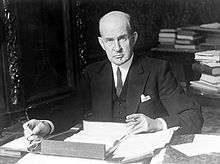Andries Cornelis Dirk de Graeff
|
Jonkheer Andries Cornelis Dirk de Graeff |
|
|---|---|
 |
|
| Governor-General of the Dutch East Indies | |
|
In office 26 March 1926 – 11 September 1931 |
|
| Preceded by | Dirk Fock |
| Succeeded by | Bonifacius Cornelis de Jonge |
| Minister of Foreign Affairs | |
|
In office 26 May 1933 – 24 June 1937 |
|
| Preceded by | Charles Ruijs de Beerenbrouck |
| Succeeded by | Hendrikus Colijn |
| Personal details | |
| Born |
7 August 1872 The Hague, Netherlands |
| Died | 24 April 1957 (aged 84) The Hague, Netherlands |
| Nationality | Dutch |
| Spouse(s) | Caroline Angelique van der Wijk (1877-1936) |
| Children | 5 |
| Occupation | Statesman |
| Religion | Remonstrants |
Jonkheer Andries Cornelis Dirk de Graeff (7 August 1872 – 24 April 1957) was a Governor General of Dutch East Indies and a Dutch minister for foreign affairs.
Andries Cornelis Dirk de Graeff was a descendant of the De Graeff-family from the Dutch Golden Age. He was a son of the general consul and Dutch minister in Japan Dirk de Graeff van Polsbroek, and jonkvrouw Caroline Angelique van der Wijk, daughter of jonkheer Carel Herman Aart van der Wijck. They had a son and four daughters.
from 1919 to 1922 De Graeff was a Dutch Ambassador in Tokyo, and from 1922 to 1926 in Washington.
He served as Gouvernor General between 26 March 1926 and 11 September 1931.
De Graeff was also the Dutch minister for foreign affairs for an unspecified period during 1936 and 1937. During 1936, de Graeff served as a "sort of stooge" to British Foreign Secretary Anthony Eden in relation to the question of weakening the League of Nations.
De Graeff wanted to "modify the League until it became "purely consultive", coax Germany back into it, and abolish forever all Sanctions "except the one Sanction that an aggressor would be automatically expelled from the League"".
...
Wikipedia
